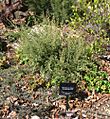Waxflower facts for kids
Quick facts for kids Waxflower |
|
|---|---|
 |
|
| Chamelaucium uncinatum | |
| Scientific classification |
|
| Kingdom: | Plantae |
| Clade: | Tracheophytes |
| Clade: | Angiosperms |
| Clade: | Eudicots |
| Clade: | Rosids |
| Order: | Myrtales |
| Family: | Myrtaceae |
| Subfamily: | Myrtoideae |
| Tribe: | Chamelaucieae |
| Genus: | Chamelaucium Desf. |
| Type species | |
| Chamelaucium ciliatum |
|
| Diversity | |
| About 30 species. | |
Chamelaucium, also called waxflower, is a group of shrubs. These plants are found only in the southwestern part of Western Australia. They are part of the Myrtaceae family, which also includes plants like eucalyptus. Waxflowers have blooms that look a bit like those of tea-trees. The most famous type is the Geraldton Wax (Chamelaucium uncinatum). People grow it a lot because its flowers are big and beautiful.
Contents
What Waxflowers Look Like
Waxflower plants are woody shrubs that stay green all year. They can be as small as 15 centimeters (6 inches) or grow up to 3 meters (10 feet) tall. Their leaves are small to medium-sized. They grow in pairs on opposite sides of the stems.
The leaves have tiny oil glands inside them. This makes them smell nice, especially when you crush them. The flowers are small and have five petals. They also have ten stamens, which are the parts that make pollen. After the flowers, small, hard fruits grow.
Naming and Plant Families
The group of plants called Chamelaucium was first named in 1819. A French botanist named René Louiche Desfontaines gave them their name. We are not sure exactly where the name came from.
People often call them waxplants or wax flowers. This is because their petals feel a bit waxy. There are about 14 different types, or species, of waxflowers known today. Chamelaucium also gives its name to a group of related plants. This group is called the Chamelaucium alliance. It includes other plants like Verticordia, Calytrix, and Darwinia. All these plants are part of the Myrtaceae family.
Types of Waxflowers
Here are some of the different species of Chamelaucium:
- Chamelaucium axillare – Esperance waxflower
- Chamelaucium brevifolium
- Chamelaucium ciliatum
- Chamelaucium confertiflorum
- Chamelaucium drummondii
- Chamelaucium gracile
- Chamelaucium heterandrum
- Chamelaucium marchantii
- Chamelaucium megalopetalum – Large waxflower
- Chamelaucium micranthum
- Chamelaucium pauciflorum
- Chamelaucium uncinatum – Geraldton waxflower, Geraldton wax
- Chamelaucium virgatum
Where Waxflowers Grow
Chamelaucium plants are only found in the southwest part of Western Australia. They usually grow in areas with low, open shrubs called heathland. These areas often have sandy soil near the coast or further inland. Some waxflowers also grow on granite rocks. A few types can even grow in drier, semi-desert climates.
Growing Waxflowers
If you want to grow waxflowers, they do best in dry places. They need soil that drains water well and a spot that gets lots of sun. These plants are tough and can handle frost and dry weather. However, they can be sensitive to a plant disease called Phytophthora cinnamomi.
The Geraldton Wax (C. uncinatum) is the most popular type to grow. Many people plant it in their gardens across Southern Australia. It is also grown for the cut flower industry. This means its flowers are picked and sold to florists in places like the USA and Israel.
Images for kids
See also
 In Spanish: Flor de cera para niños
In Spanish: Flor de cera para niños



